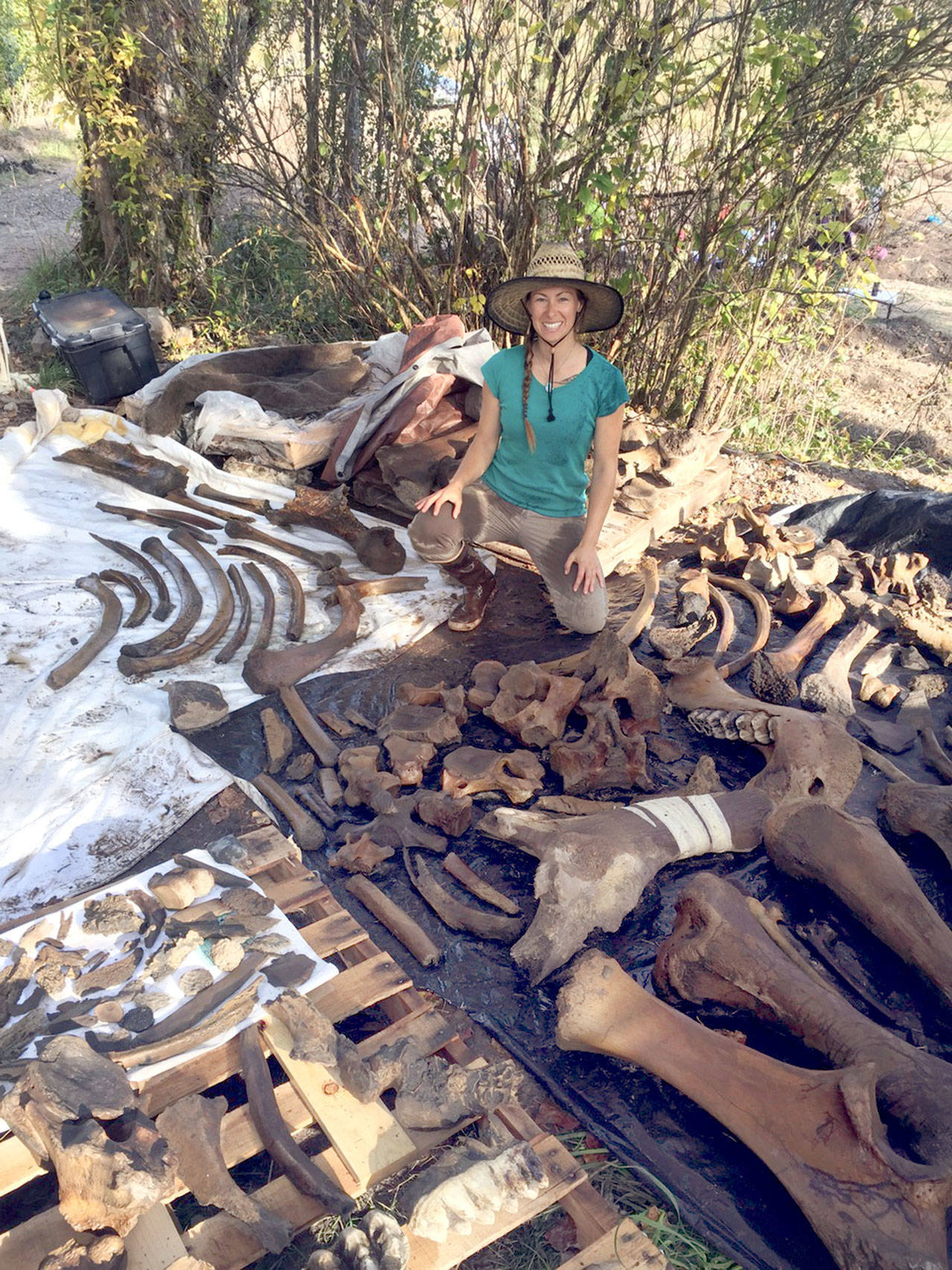CHIMACUM — Students from the Windward School were up to their elbows in dirt and mud last week on a local farm as they searched for mastodon bones estimated to be more than 10,000 years old.
A local farmer found a few bones this summer as he was excavating a portion of his field to install a pond. While he was digging with a backhoe, he hit something hard and shaped like a log. He also found a few smaller fragments.
Upon further examination, he realized that the big object was a very large femur.
Elisa Weiss, lead teacher for the Windward program, a partnership with Northwest Discovery Lab and 4-H, is a friend of the farmer, who wanted to remain unidentified for privacy reasons and to protect the site’s location.
“They didn’t look like domestic cow bones, as they were much bigger,” Weiss said as she inspected them.
“We contacted the Burke Museum at the University of Washington, described them and sent photos,” she said. “They confirmed the bones are from a mastodon, a mammut.”
She said the museum told them to keep the bones out of the sun and keep them moist.
Weiss said the farmer was facing a dilemma.
“He doesn’t want to ruin them, but he lives on a working farm and is trying to continue farm operations and build his pond.”
Danell Mackey, executive director of Northwest Discovery Lab that operates the Windward School in Port Townsend, saw this as an opportunity.
Knowing how much work the excavation could be and that the farmer didn’t have much support, Mackey had a light bulb idea: let her classes help dig up the bones.
Last week, 80 students from Clallam, Jefferson and Kitsap counties and some of their parents spent the day searching through the area on a quest for bones. The dig site of about 30 feet by 50 feet was in a marshy area.
After five days of digging, the students unearthed over 200 bones and fragments. In addition to a tusk, a femur, a mandible with teeth and vertebra were found.
“There were also remnants of other animals, including broken femurs from an animal larger than a modern deer, possibly some kind of ungulate,” Weiss said. “And some bird bones. So there were other species of animals in the area at this time.”
“Who knew that Chimacum might be the new center for education on the mastodon,” Mackey said.
“How many more of these animals are there on this property? It’s interesting to think about what we don’t know. This is an opportunity for learning.”
In 1977, mastodon bones were found in Sequim in a similar fashion — a farmer digging a pond changed North America’s prehistory.
The Manis Mastodon gained fame and world recognition due to the fact a spear point made from a different bone was embedded in a rib bone, which dates the area’s earliest human inhabitants 800 years older than the Clovis people. The area was placed on the National Register of Historic Places in 1978. Some of the bones are on display at The Sequim Museum & Arts Center.
“At the Chimacum site, this was a bog where animals came to congregate and drink,” Weiss said. “Some of them came here to die. This could have been a bone pile from prehistoric humans, either as a bone yard or they were saving carcasses to feed on as some kind of ancient refrigeration system in a frozen pond.
“We have a responsibility to the bones to learn from them,” she said.
Ruby Groussman, 8, of Port Townsend thought at first it was a Halloween joke.
“When I pulled out my first bone I was so amazed, because I had never done that in my whole life before. I found 10 bones including a tooth, a leg and a joint and a toe.”
Zeke Banks, 9, of Port Townsend said he didn’t think it was real, either.
“I was thinking it was a prank and someone buried plastic bones. I found eight bones, including two kneecaps and a ball joint. The teachers explained what they were. I guessed on some of them.”
“I was amazed that they were living animals at one point,” said Andre Mackey, 11, of Port Townsend. “And I’m digging them up in Chimacum. How is this real? It felt incredible.
“Honestly, I want to go around and keep doing this work. I feel it would be really interesting.”
Weiss said she’d like to have the project continue as an educational one for her students.
“I want to preserve the bones and articulate the skeleton, she said. “And maybe have the kids help with that. We can learn a lot of metaphorical lessons as well as the science. How can we be mindful and treat something that’s very old, fragile and breakable?
“Also, the overall idea that these animals possibly went extinct from impacts of human behavior: over hunting, lack of conservation. How does that translate to our day-to-day lives now; how we can have an impact on other species other than ourselves?
“How can we learn from the past to be better humans in the present? It can be a powerful symbol for that,” Weiss said.
“Perhaps this can be the impetus for an education center of some kind in Chimacum.”
________
Jefferson County Editor/Reporter Jeannie McMacken can be reached at 360-385-2335 or at jmcmacken@peninsuladailynews.com.

